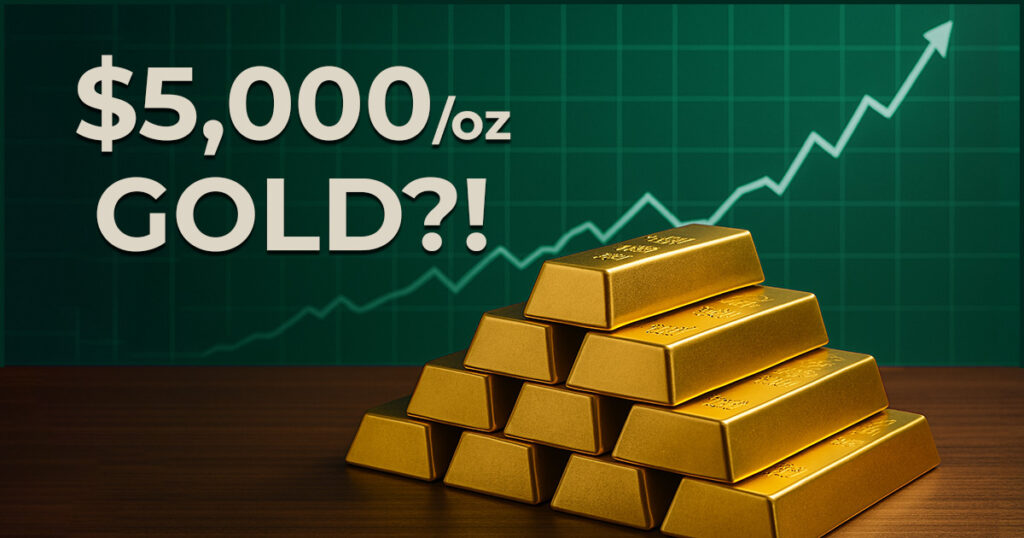For centuries, the United States has been a paragon of financial stability, strength, and consistency on the world stage. However, the country’s unsustainable debt path is putting that reputation at risk as the dollar weakens and bond yields spike, signaling a lack of faith in American financial hegemony.
In this week’s The Gold Spot, Scottsdale Bullion & Coin Precious Metals Advisors Joe Elkjer and Todd Graf discuss the downgraded credit ratings of the US government and major financial institutions, increased warnings from private-sector fiscal leaders, and why gold at $5,000 an ounce may be here sooner than many realize.
The United States Loses Perfect Credit Rating
Late last week, Moody’s downgraded the US from its highest level of Aaa to Aa1, dealing a significant blow to the country’s fiscal reputation. This comes years after the firm lowered America’s financial outlook, citing mounting concerns about debt. Now, all three of the world’s major credit rating agencies have revoked the country’s pristine creditworthiness.
In its report, Moody’s analysts highlighted several factors for the demotion:
- National Debt: The towering $36 trillion is drastically reducing the dollar’s value, stability, and confidence on the world stage.
- Interest Payments: The costs of servicing the debt consume $1 trillion of the annual federal budget, greater than the defense budget.
- Debt-to-GDP Ratio: US debt is fast outpacing its economic output, with Moody’s predicting the debt-to-GDP ratio could balloon to 134% by 2035.
- Subsequent Admin Failures: The downgrade was further attributed to persistent failures by subsequent administrations to address the debt issues.
“We’re so far in debt, and we’re spending more and more as time goes on. It’s not going to be good for our country or our currency.”
Moody’s Takes Aim at Banks
Only three days after downgrading the US’s perfect credit rating, Moody’s cut the long-term credit rating of Bank of America, Wells Fargo, and JP Morgan Chase. These three pillars of US banking dropped from an Aa1 to an Aa2 score. The downgrade was directly linked to the government’s unsustainable debt accumulation and how this burden reduces its ability to prop up these financial institutions.
This is a major red flag for the banking sector, which could face higher borrowing costs, more regulatory scrutiny, declining investments, and lower depositor confidence. These obstacles come as some of the country’s largest banks conceal over a trillion in hidden losses, signaling deep vulnerabilities in the financial system and raising concerns about the true health of the banking sector.
“Everything the dollar is experiencing is compounding, and I think the downgrades will accelerate.”
Financial CEOs Warn Investors
An increasingly vocal chorus of banking and financial leaders is cautioning of the fiscal risks on the horizon should the US fail to course correct:
- JP Morgan & Chase CEO Jamie Dimon recently cautioned investors not to underestimate the growing economic headwinds stemming from debt growth and tariff-induced uncertainty, saying the market exhibits signs of an “extraordinary amount of complacency.”
- Citigroup CEO Jane Fraser believes “something deeper is going on” in the market as “Treasury yields rose, equity markets wobbled, [and] the US dollar has weakened at moments when it used to rally,” indicating that “investors are reevaluating the credibility of long-held certainties.”
- Billionaire investor Ray Dalio warns that the real risk to US Treasurys is greater than Moody’s downgrade suggests, arguing that credit agencies ignore the bigger threat of the government “printing money to pay their debts,” which erodes the value of returns.
Together, these warnings paint a clear picture: confidence in the US financial system is wavering, investors may be underestimating the storm ahead, and the time to find shelter is now.
THE END is HERE:
WHAT if you threw a party and no one showed up?
That is what happened yesterday.
The Fed held an auction for US Bonds and no one showed up.
So the Fed quietly bought $50 billion of its own fake money with fake money.
The party is over. Hyperinflation is…
— Robert Kiyosaki (@theRealKiyosaki) May 21, 2025
$5,000/oz Gold Might Be Coming Faster Than You Think
While the US government and banking system receive downgrades, gold has been upgraded as Tier 1 Collateral—cementing the metal’s foundational role in the global financial system. The simultaneous decline of the dollar and USD-linked institutions, along with the rise of gold in terms of value and usage, has blown the lid off expert forecasts.
The yellow metal has been climbing in $500 increments at an accelerating pace, meaning each leg up is taking less time, bringing the next peak closer than many expect. Given the metal’s recent dip from an all-time high of $3,500/oz, many analysts are encouraging investors to “buy the dip” while it lasts.
Now, a growing number of analysts are predicting that gold prices at $5,000/oz could come faster than investors might think. Check out our latest article below for a full breakdown, or reach out to your advisor and ask them to send it your way.
👉 Suggested Reading: $5,000 Gold?! Why It Might Be Coming Faster Than You Think
Question or Comments?
If you have any questions about today’s topics or want to see us discuss something specific in a future The Gold Spot episode, please add them here.
Comment




Questions or Comments?
"*" indicates required fields